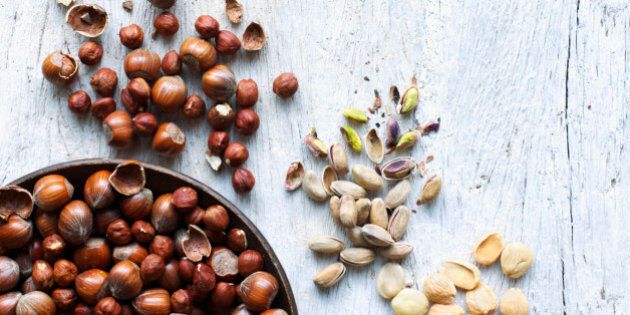
Research from the 2011-13 Australian Health Survey, summarised by Nuts For Life shows Australians aren’t eating nearly enough nuts -- despite our daily requirement being a small handful.
Nut consumption has benefits associated with decreasing heart disease as well as slowing the rise of blood glucose levels after a meal in people with type 2 diabetes.
But according to the survey, Australians consume just six grams of nuts on average each day -- which means we should be increasing nut consumption by 350 percent.
Katherine Baqleh, an accredited practising dietitian of Health Victory Nutrition Experts explains a lingering theme in her everyday interactions is that people tend to think nuts are high in fat and therefore should be avoided.
“I spend a lot of time educating my clients on the difference between the healthier fats (mono and polyunsaturated) and the unhealthy fats (saturated) and the importance of including them into the diet,” Baqleh told The Huffington Post Australia.
While many would argue the savoury snacks are overpriced and more hassle than they’re worth (sorry, pistachios) Baqleh explains in just one week of eating nuts, your risk of heart disease is still lower than those who don’t consume any at all.
However, Baqleh warns due to nuts being very energy dense, overeating them can easily add several hundred extra calories to your daily intake, contributing to weight gain. Sadly, this goes for your spoonful(s) of Nutella, too.
So which nuts are the best kind?
“Think of nuts the same way you think of fruits and vegetables,” Lisa Yates, Nuts for Life dietitian and program manager told HuffPost Australia.
“As plant foods, each nut type has a range of different nutrients so if you’re eating mixed nuts, you’re going to get a bit of all those nutrients,” Yates said.
“Certainly if you’ve got a particular condition, for instance, if you’re lactose intolerant and are unable to have dairy you’ll therefore need to up your calcium intake and almonds are great for that,” Yates said.
Nut spreads are a great option, too.
"It doesn't have to be the 100 percent nut spread either -- the standard 90 percent nuts spread is absolutely fine -- and more palatable," Baqleh said.
As for which nuts provide which fats, Baqleh said almonds and cashews contain monounsaturated fat while walnuts contain polyunsaturated fat.
While the Australian Dietary Guidelines advise 30 grams of nuts each day is sufficient, new research out of the American Journal of Clinical Nutrition found people can benefit from increasing intake to two handfuls -- especially those people with type 2 diabetes.
“One of the key findings was that people with type 2 diabetes who consumed two handfuls of nuts each day saw a reduction in Apolipoprotein B associated with LDL (low density lypoprotein),” Yates said.
However, Baqleh reminds us those guidelines are there to help us consume foods from all food groups which is why she believes while two handfuls can’t hurt us, one handful is still sufficient.
“Two handfuls per day can be fine (particularly almonds and walnuts) as it significantly lowers total and LDL cholesterol by five and seven percent respectively, but given that there are five food groups, it is important that we have snacks from all food groups (such as yoghurt, fruit, vegetables) before we reach out for a second helping of nuts,” Baqleh said.
“Of course there are some population groups that will benefit from the two serves, such as the elderly with malnutrition or those with heart conditions, but not everyone has a large calorie requirement and this can become a concern due to many Australians struggling to reach the physical activity guidelines,” Baqleh said.